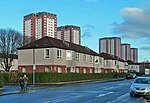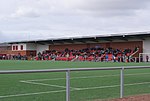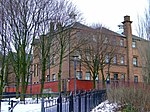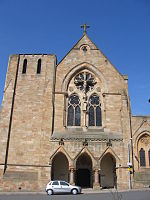Glasgow Works

Glasgow Works, formerly the St Rollox Works, is a railway rolling stock heavy maintenance and repair works established in the 1850s in the Glasgow district of Springburn by the Caledonian Railway Company, and known locally as 'the Caley'. Ownership of the works passed to the LMS in the 1920s and then to British Rail in the 1940s, with the size of the works reduced in the 1980s under British Rail Engineering Limited management. It was sold as part of the privatisation of British Rail in 1995 and after a number of ownership changes was most recently operated by Mutares-owned subsidiary Gemini Rail under a lease from the landlord, Hansteen Holdings. It has been closed since July 2019 but the site was purchased by a firm owned by Optical Express founder David Moulsdale in 2021.
Excerpt from the Wikipedia article Glasgow Works (License: CC BY-SA 3.0, Authors, Images).Glasgow Works
Charles Street, Glasgow Garngad
Geographical coordinates (GPS) Address Nearby Places Show on map
Geographical coordinates (GPS)
| Latitude | Longitude |
|---|---|
| N 55.872 ° | E -4.232 ° |
Address
Glasgow Works
Charles Street
G21 2QH Glasgow, Garngad
Scotland, United Kingdom
Open on Google Maps







